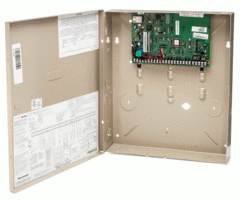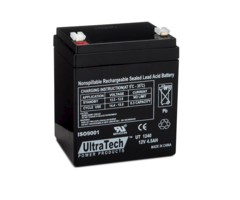The Range and Battery Life of Z-Wave Plus
PostedHi DIYers! Today, we plan to talk about some of the specifications of Z-Wave Plus and how the protocol has been improved over classic Z-Wave communication. Setting up some Z-Wave Plus devices with your system is a great way to get started in the exciting world of home automation!

You probably see us talking about Z-Wave Plus all of the time, but you might not know why we get so excited about it. If you didn't know, Z-Wave Plus is a wireless communication protocol that is frequently used with smart home devices. This includes peripherals like smart lights, door locks, programmable thermostats, and more. Many of the systems we sell and support include built-in Z-Wave controllers so you can start pairing these convenient devices. Today, a collective group called the Z-Wave Alliance is working to further improve upon this robust and convenient form of local wireless communication.
By nature, Z-Wave offers many important advantages. Wireless communication makes installation and set up super easy, which is great for DIYers who don't want to hire a professional installer. And by using them with your monitored security system, you can operate these devices remotely through an automation platform like Total Connect 2.0 or Alarm.com. Both platforms offer their own mobile app so that you can control these devices from virtually anywhere! And you can even establish smart scenes so that your Z-Wave devices operate automatically based on a schedule or with certain events on your system. How cool!
But not all Z-Wave devices are created equal. More recently, we have seen the rise of "Z-Wave Plus" devices, also known as 500-Series devices. This is as opposed to what we sometimes refer to as "classic Z-Wave" devices, or 300-Series devices. When given the option, you will definitely want to go with the newer and more advanced Z-Wave Plus 500-Series devices. This will provide you with the best possible end user experience.

Before we get into Z-Wave Plus specifications, we want to quickly mention what you will need to achieve a Z-Wave Plus setup. To unlock the full potential of Z-Wave Plus, you will need a Z-Wave Plus controller and certified Z-Wave Plus devices. You can use classic Z-Wave devices with a Z-Wave Plus controller, but you will only get the functionality of classic Z-Wave.
Likewise, you can use Z-Wave Plus devices with a classic Z-Wave controller, but again, you will only have the same 300-series functionality. If you want true Z-Wave Plus, you must have a Z-Wave Plus controller and certified Z-Wave Plus devices. Check for the label shown at the top of this post to determine if a device is Z-Wave Plus. That label should be found somewhere on the product box.
Now that we have that out of the way, you might be wondering what's the big deal about Z-Wave Plus. After all, you can technically do anything with classic Z-Wave that you can do with Z-Wave Plus. The thing is though, Z-Wave Plus can do it better. This comes down to a few different considerations. Namely, Z-Wave Plus offers further range, extended battery life, and better reliability overall.

When it comes to Z-Wave range, signal hopping is key. Z-Wave signals actually have the ability to "hop" through other Z-Wave devices. Each time a "hop" occurs, the signal is repeated to extend the range. A Z-Wave signal can make up to four (4) of these hops on its way to the intended destination. By adding more Z-Wave devices, you are establishing a stronger mesh network.
Z-Wave Plus devices allow for about 50 to 60 feet between hops. So you can expect a roughly 200 foot range for a Z-Wave Plus device if you have a strong mesh network for signal hopping. Conversely, a classic Z-Wave device will only offer a range of about 30 to 40 feet between hops. That's only a range of about 120 feet with a strong mesh network. By using exclusively Z-Wave Plus devices, you are getting a roughly 66% increase in range!
Battery life is also something to consider for Z-Wave devices that do not plug in or connect with electrical wiring. This is common for most Z-Wave locks and even some thermostats like the Honeywell T6 Pro Z-Wave. The Z-Wave Alliance designed Z-Wave Plus devices to consume less power, which has improved their expected battery life by about 50%. This will save you money with fewer required battery changes!
Lastly, you should consider the fact that Z-Wave Plus offers better reliability than classic Z-Wave. This is important for ensuring that any Z-Wave commands and signals ultimately reach their intended destinations. Certified Z-Wave Plus devices are also required to support Security S2, which includes complete Diffe-Hellman Symmetric Encryption for enhanced security. And perhaps most importantly, Z-Wave Plus devices can receive firmware updates over-the-air (OTA), allowing developers to streamline any needed improvements.

The future certainly looks bright for Z-Wave, as the Z-Wave Alliance is currently working on 700-Series Z-Wave Communication. This represents the future over the current Z-Wave Plus 500-Series. We do not have the details on 700-Series, including when it will be made widely available, but it is expected to communicate up to 150% further, while using even less power for improved battery life! These devices will also offer enhanced processing for signal transmissions that are up to 18% faster.
At this time, no security systems support 700-Series technology. But there are still fantastic systems like the Qolsys IQ Panel 2 Plus which support Z-Wave Plus 500-Series communication. With Z-Wave on your side, you can truly make your alarm system stronger than ever and achieve a more convenient life! If you have any questions about Z-Wave technology, you are welcome to email us at support@alarmgrid.com. Remember that our support hours are from 9am to 8pm ET M-F. We look forward to hearing from you!

















